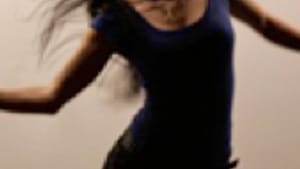Stay in the Loop
BSR publishes on a weekly schedule, with an email newsletter every Wednesday and Thursday morning. There’s no paywall, and subscribing is always free.
Theater of the future
Whit MacLaughlin's "Fatebook' at Live Arts Festival (2nd review)

Fatebook might have been the most original conception and presentation of the recent Live Arts 2009 Festival. It was surely the most labor-intensive, with an impressive set, sound and media design. Its fashioning of original art out of the newest social media modes of communication is a groundbreaking step into a theater of the future.
Fatebook had an elaborate totally virtual life for months before the production opened, a time when anyone could access its dozen youthful characters on the web, each of them creating their own virtual lives with videos and updates— an entire production in itself. During this time you could "friend" a character on Facebook, or "follow" a character on Twitter, relating to them via virtual reality communication. It was like holding a virtual conversation and conducting your own personal investigation into a character in a novel or a play.
In keeping with this virtual thread, the real-life actors of Fatebook had initially auditioned by sending one-minute YouTube videos of themselves to director Whit MacLaughlin— videos that can be viewed on the characters' web pages. (See, for example, www.fatebooktheshow.com.)
I approached all of this pre-production activity with a degree of curmudgeonly skepticism. But I must say that the show and its characters were sufficiently compelling, that I've retrospectively re-visited the site to sample its well-made videos.
Live action, filmed action
After a bit of playful introduction in video real-time by a young woman (Emily Letts), we visit a dozen ceiling-high video screens with the formerly virtual— now live— characters before them. Their narratives also inhabit the videos behind them— sometimes eerily so, via the synchronicity of live and filmed narrative and action.
As you focus on one live performer or film narrative, the performers move about into other settings, interacting with other performers and videos. We're invited to follow them in real time and space, just as we would "follow" a Facebook friend. Whatever resistance I had to follow a Fatebook character in the pre-performance months began to dissolve amid the magnetic pull of the live performance.
Intersecting stories
To complicate the sly web that MacLaughlin weaves for us, the narratives intersect in seemingly incomprehensible but at other times related and logical ways. The narratives all repeat themselves in five return loops, each ending with a rather gratuitous gunshot-to-your face scene. Three fates/witches serve as the freewheeling cross-pollinators of the whole production, weaving in and out of videos and live actions alike.
One versatile character called Danh Marks (played by Nhut Le) brought an engaging physical energy and commitment (as well as some hip-hop moves) to his role. His video, capturing signs on walls reading "dwarfism" and "freaks" as well as his rejection by young women, helped generate real interest and empathy with his character.
A boyfriend in Afghanistan
Another character, June Summer McCarthy (played by Samantha Kristina Clarke), had recorded on her earlier Fatebook site that Bobby, her boyfriend of seven years, was in Afghanistan, and in the terse messaging format of her page she adds, "Not sure what he's doing. I just want him back." In the live performance the same character has lost her boyfriend in a battlefield death, and she is comforted on the floor by another woman who folds into her body. The play of virtual text and live performance resonates powerfully here.
The acting by a very young cast was uneven, but then they were grappling with a huge challenge. (My filmmaker friend Peter Rose remarked that the production and its virtual realities reminded him of the old silent films.) Some critics have viewed the youthful actors' personal narratives as banal or pedestrian— which may be true, but which may reflect the generational bias of elders.
Generation gap
The gaps in performance chops of the actors were often saved by outstanding video projections that utilized Philadelphia settings like the new Piazza apartment complex in Northern Liberties, a nightscape scene under the I-95 highway in south Philadelphia, and some of the city's narrow, alley-wide streets. The brilliance of the set, media and projection designs by Matt Saunders and Jorge Cousineau fully matched the originality of MacLaughlin's conception.
The arts have long investigated and navigated the worlds of multiple realities that artistic imaginations have created. The past century's technologies— especially photography and film—have enhanced these pursuits. As Fatebook demonstrates, the Internet and its offspring are now generating new art forms that are fresh sources of both wonderment and enlightenment.♦
To read another review by Jim Rutter, click here.
Fatebook had an elaborate totally virtual life for months before the production opened, a time when anyone could access its dozen youthful characters on the web, each of them creating their own virtual lives with videos and updates— an entire production in itself. During this time you could "friend" a character on Facebook, or "follow" a character on Twitter, relating to them via virtual reality communication. It was like holding a virtual conversation and conducting your own personal investigation into a character in a novel or a play.
In keeping with this virtual thread, the real-life actors of Fatebook had initially auditioned by sending one-minute YouTube videos of themselves to director Whit MacLaughlin— videos that can be viewed on the characters' web pages. (See, for example, www.fatebooktheshow.com.)
I approached all of this pre-production activity with a degree of curmudgeonly skepticism. But I must say that the show and its characters were sufficiently compelling, that I've retrospectively re-visited the site to sample its well-made videos.
Live action, filmed action
After a bit of playful introduction in video real-time by a young woman (Emily Letts), we visit a dozen ceiling-high video screens with the formerly virtual— now live— characters before them. Their narratives also inhabit the videos behind them— sometimes eerily so, via the synchronicity of live and filmed narrative and action.
As you focus on one live performer or film narrative, the performers move about into other settings, interacting with other performers and videos. We're invited to follow them in real time and space, just as we would "follow" a Facebook friend. Whatever resistance I had to follow a Fatebook character in the pre-performance months began to dissolve amid the magnetic pull of the live performance.
Intersecting stories
To complicate the sly web that MacLaughlin weaves for us, the narratives intersect in seemingly incomprehensible but at other times related and logical ways. The narratives all repeat themselves in five return loops, each ending with a rather gratuitous gunshot-to-your face scene. Three fates/witches serve as the freewheeling cross-pollinators of the whole production, weaving in and out of videos and live actions alike.
One versatile character called Danh Marks (played by Nhut Le) brought an engaging physical energy and commitment (as well as some hip-hop moves) to his role. His video, capturing signs on walls reading "dwarfism" and "freaks" as well as his rejection by young women, helped generate real interest and empathy with his character.
A boyfriend in Afghanistan
Another character, June Summer McCarthy (played by Samantha Kristina Clarke), had recorded on her earlier Fatebook site that Bobby, her boyfriend of seven years, was in Afghanistan, and in the terse messaging format of her page she adds, "Not sure what he's doing. I just want him back." In the live performance the same character has lost her boyfriend in a battlefield death, and she is comforted on the floor by another woman who folds into her body. The play of virtual text and live performance resonates powerfully here.
The acting by a very young cast was uneven, but then they were grappling with a huge challenge. (My filmmaker friend Peter Rose remarked that the production and its virtual realities reminded him of the old silent films.) Some critics have viewed the youthful actors' personal narratives as banal or pedestrian— which may be true, but which may reflect the generational bias of elders.
Generation gap
The gaps in performance chops of the actors were often saved by outstanding video projections that utilized Philadelphia settings like the new Piazza apartment complex in Northern Liberties, a nightscape scene under the I-95 highway in south Philadelphia, and some of the city's narrow, alley-wide streets. The brilliance of the set, media and projection designs by Matt Saunders and Jorge Cousineau fully matched the originality of MacLaughlin's conception.
The arts have long investigated and navigated the worlds of multiple realities that artistic imaginations have created. The past century's technologies— especially photography and film—have enhanced these pursuits. As Fatebook demonstrates, the Internet and its offspring are now generating new art forms that are fresh sources of both wonderment and enlightenment.♦
To read another review by Jim Rutter, click here.
What, When, Where
Fatebook: Avoiding Catastrophe One Party at a Time. Created by Whit MacLaughlin and New Paradise Laboratories. Live Arts Festival production through September 19, 2009 at 919 N. Fifth St. (215) 413.1318 or www.pafringe.com/details.cfm?id=6854.
Sign up for our newsletter
All of the week's new articles, all in one place. Sign up for the free weekly BSR newsletters, and don't miss a conversation.

 Jonathan M. Stein
Jonathan M. Stein